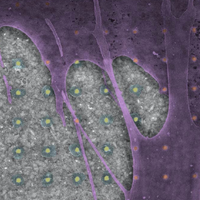
Microelectrode arrays are used for monitoring bioelectric activity in neurons and cardiomyocytes, but their wiring has a narrow bandwidth for transmitting bioelectric signals. They also have limited spatial resolution and are hard to use for large-scale cell measurements. Researchers led by Ali Yanik, an electrical engineer at the University of California, Santa Cruz, have developed ultrasensitive nanoscale optical probes that can measure many individual cells simultaneously. Their work was published in Science Advances October 18.
The new nanoprobes feature a nanoantenna array that allows researchers to read signals remotely instead of using wiring, bypassing the limitations of microelectrodes. The nanoantennae use light to detect electrical activity signals. “The electro-plasmonic nanoantenna has a resonance frequency that changes in response to the electric field, and we can see that when...

A. Habib et al., “Electro-plasmonic nanoantenna: A nonfluorescent optical probe for ultrasensitive label-free detection of electrophysiological signals,” Sci Adv, doi:10.1126/sciadv.aav9786, 2019.
Emily Makowski is an intern at The Scientist. Email her at emakowski@the-scientist.com.
Interested in reading more?




